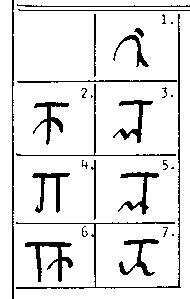| SPECIFICATIONS | |
| Denomination | massa |
| Alloy | Copper |
| Type | Struck |
| Diameter | 20.82 mm |
| Thickness | mm |
| Weight | 3.98 gms |
| Shape | Round |
| Edge | Plain |
| DieAxis | O° |


|

| 
| ||||||||||||||||||||
| Codrington #78 | Mitchiner #835 | |||||||||||||||||||||
|
Obverse : Traditional Lankan massa design of standing king. The head consists of an irregular oblong, the right side being a vertical line, from which projects three horizontal stokes representing the nose, mouth and chin. The crown bulging outwards at the back. The two curved lines on either side of the legs slightly turned upwards at the end indicate a person wearing a 'dhoti', and standing on a lotus stalk with flower to the right. The forearm is bent sharply down; the hand grasps the hanging lamp. The right side elbow is curved down with the arm turned upwards holds a flower presumed to be a jasmine blossom. To the right are five dots or spheres. A rim of 40 to 43 beads. Reverse : Traditional Lankan massa design of seated king. Head and crown as on obverse. Arm is raised upwards and the hand holds a conch shell. On right Nagari legend Sri Ka le ga la ke ja . which represents Sri Kalinga Lamkendra, the signature of the Doratiyawa tudupota | 
|
This is a rare coin unlike the six common copper massa coins from the late Polonnaruwa and Dambadeniya era. The base silver type is also known.
On the death of
To quote history from the direct translation of the ancient chronicle Culavamsa
Text edited from
The coin was scanned at 300dpi and displayed at 300dpi.
It was purchased in November 1999 from NoorHameem's one of the oldest
coin dealeships in Colombo, Lanka.
After his murder the Uparaja of King Vijayabahu, born in Kalinga,
Kittinissanka by name, became king. After he had received royal
consecration he had built in superb Pulatthinagara a beautiful temple
of stone for the Tooth Relic. He had the lofty Ratanava1i-cetiya made
firm and embellished the splendid structure with a golden point. After
building the vihara adorned with a hundred pasadas which bore his
name, he made it over to the bhikkhu community and supported it. The
Jambukola-vihra resplendent with walls and pillars shimmering in gold
and silver, where the floor was of red lead and the bricks of the roof
were of gold, the wise (Monarch) had rebuilt and placed therein
seventy-three golden statues of the Master. With the four-membered
army the Ruler full of pious devotion, went forth to the Samantakuta
and performed there his devotions, and everywhere on the island of
Tambapanni he had flower gardens and fruit gardens and numbers of
houses for the community laid down. While in this way
day by day the Ruler accumulated many a merit, he carried on the
government for nine years in most excellent fashion.
* Ceylon Coins and Currency: H. W. Codrington, Colombo, 1924.
Chapter VI Mediaeval Lanka - Sinhala of 12th & 13th Century - Series I, Page 68
* Culavamsa II Chapter LXXX: Translation by Wilhelm Geiger. Pali Text Society 1930